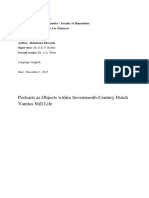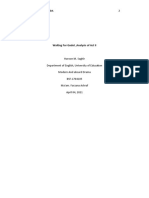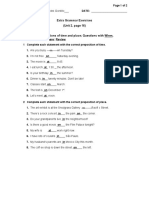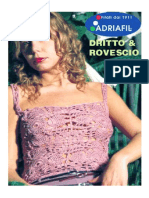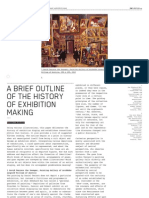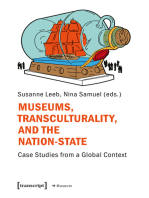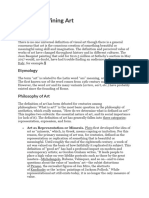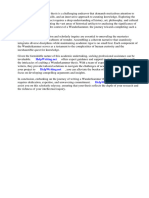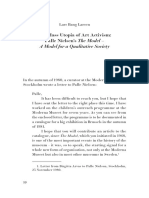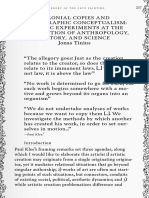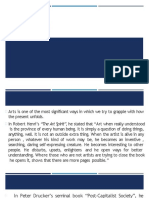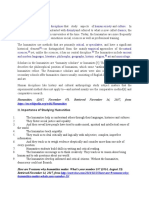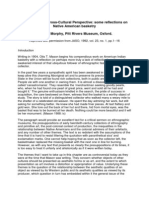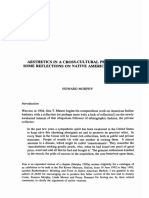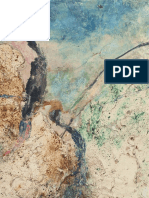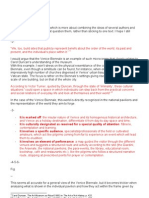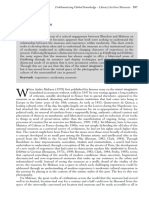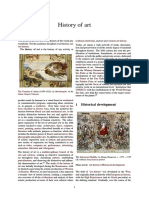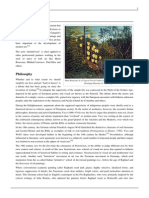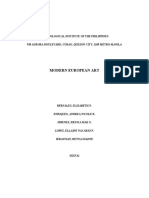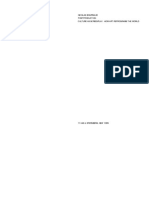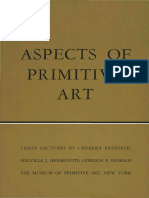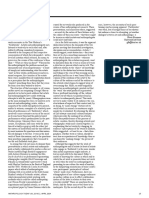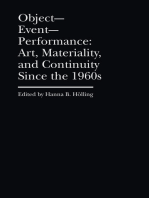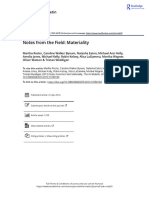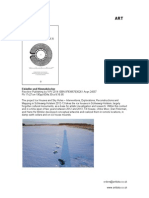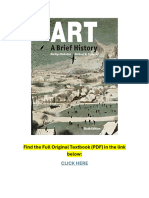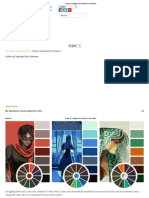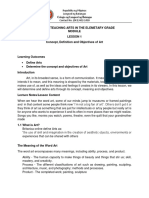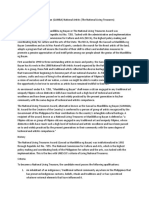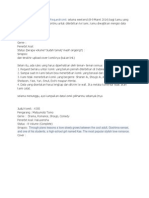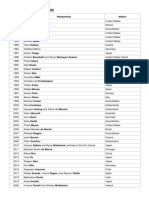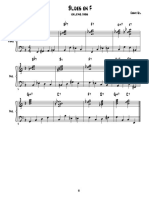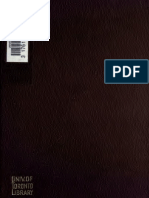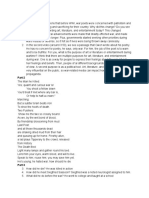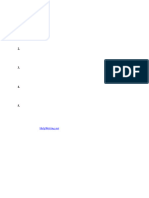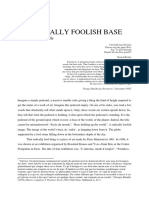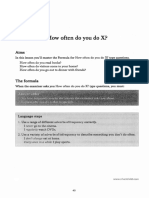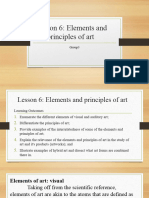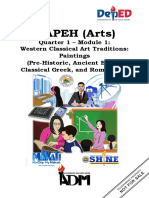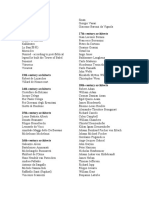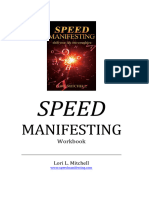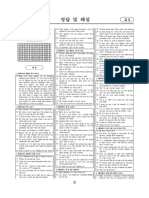This Content Downloaded From 152.32.112.162 On Tue, 29 Mar 2022 06:43:57 UTC
This Content Downloaded From 152.32.112.162 On Tue, 29 Mar 2022 06:43:57 UTC
Uploaded by
cheriz atoCopyright:
Available Formats
This Content Downloaded From 152.32.112.162 On Tue, 29 Mar 2022 06:43:57 UTC
This Content Downloaded From 152.32.112.162 On Tue, 29 Mar 2022 06:43:57 UTC
Uploaded by
cheriz atoOriginal Title
Copyright
Available Formats
Share this document
Did you find this document useful?
Is this content inappropriate?
Copyright:
Available Formats
This Content Downloaded From 152.32.112.162 On Tue, 29 Mar 2022 06:43:57 UTC
This Content Downloaded From 152.32.112.162 On Tue, 29 Mar 2022 06:43:57 UTC
Uploaded by
cheriz atoCopyright:
Available Formats
The Currencies of Naturalism in Dutch "Pronk" Still-Life Painting: Luxury, Craft,
Envisioned Affluence
Author(s): Miya Tokumitsu
Source: RACAR: revue d'art canadienne / Canadian Art Review , 2016, Vol. 41, No. 2, The
Nature of Naturalism: A Trans-Historical Examination / La nature du naturalisme: un
questionnement transhistorique (2016), pp. 30-43
Published by: AAUC/UAAC (Association des universités d’art du Canada / Universities
Art Association of Canada)
Stable URL: https://www.jstor.org/stable/44011805
JSTOR is a not-for-profit service that helps scholars, researchers, and students discover, use, and build upon a wide
range of content in a trusted digital archive. We use information technology and tools to increase productivity and
facilitate new forms of scholarship. For more information about JSTOR, please contact support@jstor.org.
Your use of the JSTOR archive indicates your acceptance of the Terms & Conditions of Use, available at
https://about.jstor.org/terms
is collaborating with JSTOR to digitize, preserve and extend access to RACAR: revue d'art
canadienne / Canadian Art Review
This content downloaded from
152.32.112.162 on Tue, 29 Mar 2022 06:43:57 UTC
All use subject to https://about.jstor.org/terms
The Currencies of Naturalism in Dutch PronkStill-Life Painting:
Luxury, Craft, Envisioned Affluence
MiyaTokumitsu
En tant que mode de représenta- Windows, mirrors, maps: The surfaces of naturalistic paintings continuous-
tion, le naturalisme des natures
mortes ostentatoires néerlan- ly invite comparisons to other representational planes, particularly those
daises du xvii6 siècle suscite un that connote a heightened level of informational value, and suggest- or
désir consumériste. Pourtant,
comme le mot l'indique, le na-
even claim outright- that the pictures in question can reveal truths beyond
turalisme vise la représentation what the eye alone can observe.1 In the case of the Dutch pronk (or "show"2)
d'objets, de figures, et d'espaces
d'une manière qui imite la réa-
still-life paintings of the seventeenth century, the insinuation of value-laden
lité. Comment les pronkstilleven information imbued these paintings with material and social qualities that
peuvent-elles prétendre à la vé-
rité de la représentation natu-
approached, and sometimes eclipsed, those of the rare and costly items
raliste en même temps qu'elles depicted. As this study suggests, profuse naturalistic detail loaded these works
incarnent le luxe, une forme de
plaisir personnel déterminé par
with a visual excess meant to appeal to spectators informed by new methods
la valeur sociale? Pour répondre of natural inquiry, keenly attuned to technical craftsmanship, and inclined to
à cette question, cet essai pour-
suit trois pistes de réflexion : le
the thrall of visualizing economic affluence. As a representational mode, the
statut de la représentation na- naturalism manifested in pronkstilleven was itself a luxury commodity invested
turaliste comme produit de luxe,
les tensions entre l'artisanat et le with a social capital that exceeded even the value of the painter's skill, materi-
travail dans ces tableaux, et en- als, and labour.
fin les distinctions entre l'abon-
dance et l'affluence codifiée This focus on new ways of knowing, materiality, and trade networks pro-
dans le naturalisme néerlandais. vides a ready platform for discussing the crafted surfaces of naturalistic paint-
MiyaTokumitsu is Lecturer in ings and their commodity status.3 These lines of inquiry also allow us to revisit
Renaissance and Early Modern Art previous scholarship and consider whether there are new conclusions to be
at the University of Melbourne in
Australia drawn from it. For instance, in her seminal text, The Art of Describing, Svetlana
-miya.tokumitsu(f)unimelb.edu.au Alpers asserts the importance of craft and making to naturalistic depiction; as
a result of the current interest in materiality, such inquiry has gained new life.4
Similarly, recent scholarship on the economies of art and knowledge in the
early modern world confirms the enduring relevance of earlier socio-econom-
i. Svetlana Alpers, The Art of
ic studies of art.5 Finally, questions about the substance (or lack thereof) behind
Describing : Dutch Art in the Seven- pronkstilleven have concerned a diverse array of thinkers, most notably, Hal Fos-
teenth Century (Chicago, 1983), 122;
Hanneke Grootenboer, The Rhetoric
ter, Norman Bryson, and Joanna Woodall.6 Might these scenes be "mere" pro-
of Perspective: Realism and lllusionism jections? Woodall's challenge to take at face value the virtual nature of these
in Seventeenth-Century Dutch Still Life
Painting (Chicago, 2005), 4-5.
pictures clarifies their place in broader discourses of displaying wealth in the
2. Julie Hochstrasser, Stil- Dutch Republic, which, 1 suggest, also rely on tropes of miraculous appear-
staende dingen: Picturing Objects
in the Dutch Golden Age," in Early
ance and immaterial projection.7
Modern Things : Objects and Their Hist- While acknowledging the value of these debates, 1 argue instead that pronk-
ories, 1500-1800, ed. Paula Findlen
stilleven embodied and communicated their covalent values as commercial lux-
(London, 2013), 107.
3. Even the recent literature ury objects, as products of human labour, and as signifiers of worldly affluence.
is vast. A brief I ist of recent schol-
arship addressing materiality in
As there is nothing inherent in commodities that accounts for their valuation,
early modern art includes Christy affirming the social roles of the commodity demands constant interpretation
30 MiyaTokumitsu The Currencies of Naturalism in Dutch Pronk Still-Life Painting
This content downloaded from
152.32.112.162 on Tue, 29 Mar 2022 06:43:57 UTC
All use subject to https://about.jstor.org/terms
Anderson, Anne Dunlop, and
on the part of the contemporary observer.8 Indeed, artworks were essential
Pamela H. Smith, eds., The Matter social objects in a culture- an early modern Republic- that increasingly under-
of Art: Materials, Practices, Cultural
stood social structure not as decreed from above, but as emerging from the
Logics, c. 1250-1750 (Manchester,
2015), and Ann-Sophie Lehmann, discourse and media that circulated in everyday life.9 1 examine how painterly
Frits Schölten, and H. Perry Chap-
man, eds., NederlandsKuristhistorisch
naturalism in pronkstilleven and the labour they entailed were essential to the
Jaarboek62 (2012), a special issue specific social reception of these works as precious commodities in the Dutch
entitled, "Meaning in Materials:
Netherlandish Art 1400-1800." On
Republic. First and foremost, the painters' overtures to sensory refinement
Dutch art and trade networks, see through their meticulous handling of paint established these paintings as
J u lie Hochstrasser, Still Life andTrade
in the Dutch Golden Age (New Ha-
luxury objects in and of themselves. Additionally, in proudly announcing the
ven, a, 2007); and see Benjamin artisanal labour of the painter and craftsman but eliding the social labour of
Schmidt, Inventing Exoticism: Geog-
raphy, Globalism, and Europe's Early
bureaucracy, transport, and material production that facilitated the existence
Modern Wor/d (Philadelphia, 2015) on of these paintings and objects they depicted, painterly naturalism in pronkstille-
global trade and early modern ma-
terial culture. ven privileged certain types of labour as more visible than others. Finally, pronk-
4. See Angela Vanhaelen and stilleven staged visions of affluence within a culture for which outward signs of
Bronwen Wilson, "The Erotics of
Looking: Materiality, Solicitation
prosperity served important social functions.
and Netherlandish Visual Cul- Definitions of naturalism are complex at any point in history- a basic
ture, " i n The Erotics of Looking : Early
definition of naturalism could be that it denotes the qualities of an image or
Modern Netherlandish Art, ed. Angela
Vanhaelen and Bronwen Wilson object by which it references the visible world. These references also carry
(Hoboken, 2013); and Nadia Baadj,
Jan van Kessel I (1626-1679) : Crafting
at least some pretence to truth of description. As Stephen Perkinson notes
a Natural History of Art in Early Modern in an important recent study of the issues of representation and naturalism,
Antwerp (T u mhout, 201 6).
5. ). Michael Montias, Artistsand
the first part of this definition is hardly precise or satisfying, for even a crude
Artisans in Delft: A Socio- Economic Study stick figure references the visible world. Naturalism, then, is partly a matter of
of the Seventeenth Century (Princeton,
NJ, 1982) and "Cost and Value in
degrees.10 And as for the idea that naturalism contains the pretence of truth,
Seventeenth-Century Dutch Art," Hanneke Grootenboer rightly points out that "truth in painting" is not a fixed
ArtHisto/y 10, 4(1987), 454-66.
6. Hal Foster, The Art of
concept even for artists working in a naturalistic mode: for quattrocento
Fetishism: Notes on Dutch Still Italian painters it meant one thing, for painters of the Dutch Golden Age, it
Life," in Fetishism as Cultural Discourse,
ed. Emily Apterand William Pietz
meant another, for photo-realists of the 1960s, yet another.11 Naturalism is
(Ithaca, 1993), 251-65; Norman also differentiated from its close relative, illusionism, which departs from
Bryson, Looking at the Overlooked: Four
Essays on Still Life Painting (1990 ; repr.
mimesis as it simulates rather than imitates reality.12 As a complex concept
London, 2001); Joanna Woodall, then, naturalism cuts across cultures and historical moments: the creation of
"Laying theTable: The Procedures
ofStill Life," in Erotics of Looking, ed.
naturalistic images and the reception of images as naturalistic are built upon
Vanhaelen and Wilson, 111-37. specific activities and expectations. These cultural conditions determined
7. Woodall, "LayingtheTable,"
especially 129-33.
which media were used and prompted particular arrays of visual effects that
8. Philip Mirowski, "Learn- artists emphasized or downplayed in pursuing naturalistic depiction.13
ing the Meaning of a Dollar: Con-
servation Principles and the So-
In the seventeenth century, Dutch painters applied paint in a way that
cial Theory ofValue in Economic made it closely resemble the surfaces of other material objects. Their pictures
Theory," Social Research 57, 3 (1990),
708. betray an interest in descriptiveness and a dedication to conveying ample vis-
9. Vanhaelen and Wilson, ual information.14 To capture and portray this amount of visual information
"Erotics of Looking, "15.
10. Stephen Perki nson, The
in paint, these artists had to depart from instinctive methods of observing
Likeness of the King : A Prehistory of Por- the world- generalizing, scanning, and selecting- and institute a new kind
traiture in Late Medieval France (Chicago,
2009), especially 36.
of inquisitive looking.15 In doing so, they invited a similarly inquisitive spec-
11. G roote n boe r, Rhetoric of Per- tatorship, one connected to broader developments in scientific inquiry, that
spective, 5.
12. Ibid., 47.
required beholders to observe what, precisely, was before their eyes.16
13. Perkinson, Likenessofthe What was before their eyes in these paintings? While pronkstilleven often
King, 36.
14. Jean Givens, Observation
made spatial overtures to the spectators' physical environment (for instance in
and Image-Making in Gothic Art (Cam- the frequent depiction of tables whose edges appear flush with the paintings'
bridge, 2005), 172. Although Givens
is focused on an earlier period of
surfaces- where painting and "real world" meet), in these works the descrip-
European art, her discussion of tive tendencies of Dutch still-life painters are trained toward visualizing luxury
RACAR 41 (2016) 2.30-43 31
This content downloaded from
152.32.112.162 on Tue, 29 Mar 2022 06:43:57 UTC
All use subject to https://about.jstor.org/terms
Figure i . Jan Davidsz. de Heem, -a conceptual "truth" that does not correspond to reality on a one-to-one
Still Life: A Banqueting Scene,
probably ca. 1640-41. Oil on
basis. For one thing, the content of many of these works- a jumbled collection
canvas, 135.3 * l85-4 cm. New of expensive goods- is fantastical, occasionally to the point of near-preposter-
York, The Metropolitan Museum
of Art, Charles B. Curtis Fund, 1912
ousness, as in the case of Abraham van Beyeren's veritable avalanches of sund-
(photo: www.metmuseum.org). ries.17 Other pronkstilleven compositions appear to mimic real assemblages that
might exist in the context of a painter's studio. ]an Vermeer, Gerrit Dou, and
]an Steen were notable Dutch painters who depicted artists' studios stocked
with piles of objects frequently represented in still lifes.18 Yet the studio is
itself a staged world of contrivance and props, as Vermeer so famously empha-
sized in The Art of Painting. The sophisticated spectators who could afford or
access fine pronkstilleven may well have known that the vision before them was
description and naturalism is ¡I-
luminatingand pertinent to this a fantasy, but nevertheless delighted in training their focused, connoisseurial
discussion.
15. Ibid., 3.
vision on the painted confections of sumptuous textures and reflections.
1 6. Lorraine Daston, "Obser- Norman Bryson claimed that pronkstilleven by painters like Willem Kalf
vation," in Prints and the Pursuit of
Knowledge in Early Modern Europe (New
and jan Davidsz. de Heem, | fig. 1 1 which teemed with exotic fruits, metal-
Haven, a, 2011), 126-33. ware, and textiles, in fact presented spectators with "the dream of wealth,"19
17. Representative of Beyeren's
opulent pronkstilleven is his compos-
as mesmerizing fantasies of affluence and plenty made beguilingly palpable
ition now in the Los Angeles County through naturalistic representation. Johann Wolfgang von Goethe had him-
Museum of Art, Banquet Still Life of
1667, accession no. M.86.96.
self famously pondered whether he would rather own the precious metal
18. H. Perry Chapman, "The vessels in a Kalf painting or the painting itself. In the end, he declared he
Imagined Studios of Rembrandt
and Vermeer," in Inventions of the
would prefer the painting.20 Goethe's thought experiment emphasizes that
Studio , Renaissance to Romanticism, ed. these paintings too were meant as objects of desire, potentially more so even
32 MiyaTokumitsu The Currencies of Naturalism in Dutch Pronk Still-Life Painting
This content downloaded from
152.32.112.162 on Tue, 29 Mar 2022 06:43:57 UTC
All use subject to https://about.jstor.org/terms
than the sumptuous goods they depict.21 Although he chooses the painting,
Goethe also finds the objects attractive, albeit distinct, which underscores the
importance of the distance between object and copy that naturalism depends
upon but illusionism suppresses.22 The naturalism in these works presented
Michael Cole and Mary Pardo (Chap-
spectators with surfaces that not only astonished through demonstrations of
el Hill, 2005), 108-146. painterly skill, but also reproduced and exceeded the spectator's desire for the
19. Bryson, Looking at the Over-
looked, 130.
objects therein. An excessive vision could stoke possessive desire as much as,
20. Johann Wolfgang von and sometimes more than, its referents.
Goethe, "Zur Erinnerung des
Städlisches Kabinetts" [1797], in
Naturalism as Luxury Commodity
Gedenksausgabe der Werke, Briefe und
Gespräche, ed. Ernst Beutler, vol. 13
(Zurich, 1954), 121. In fact, as Sam
It is well known that finely painted pictures fetched dizzyingly high prices
Segal notes, Goethe was looking at in the Dutch Republic.23 Within the Dutch art market, paintings by Vermeer
a copy of a Kalf painting. Sam Segal,
A Prosperous Past: The Sumptuous Still
and Dou could garner six hundred guilders for their glittering surfaces, while
Life in the Netherlands 1600-1700, exh. cheap pictures could be had for under ten.24 Pamela H. Smith underlines that
cat., Stedelijk Museum Het Prinsen-
hof, Delft (Amsterdam, 1988), 185.
these prices have been a topic of fascination within art historical scholar-
21. Vanhaelen and Wilson ship;25 indeed they make tangible the economic value these paintings held
argue that the material qualities of
seventeenth-century Dutch paint-
for certain members of society. The labour, and therefore the time, required
ing were ai med at captu ri ng view- to complete such finely finished works helped drive their prices skyward.
ers' attention via visually seductive
address. Vanhaelen and Wilson,
Smith notes that Dou and Frans van Mieris the Elder fastidiously tallied the
"Erotics of Looking," 9-10. number of hours they spent creating specific paintings.26 While certain-
22. Grootenboer, Rhetoric of Per-
spective, 47.
ly the skill and labour demanded by naturalistic representation were factors
23. Pamela H.Smith, The Body of propelling the prices of these paintings upward, the social value invested in
the Artisan : Art and Experience in the Sci-
entific Revolution (Chicago, 2004), 213.
painterly naturalism rendered it a special kind of object that circulated within
See also Eric J. Sluijter, "Schilders the market: a luxury. For a savvy contemporary audience, naturalistic depic-
van 'cleyne, subtile ende curieuse
dingen.' Leidse 'fijnschilders' in
tion provided aesthetic refinement and the pleasure of consuming it, qual-
contemporaine bronnen," in Leidse ities that also define the luxury commodity.
Fijnschilders: Van Gerrit Dou tot Frans
van Mieris de longe 1630-1760, ed. Eric
The concept of luxury has a long history of evolving connotations, which
J. Sluijter et al., exh. cat., Stedelijk cannot be recounted in full here.27 For the purposes of this discussion, I focus
Museum De Lakenhai Leiden
(Zwolle, 1988), 26ff.
on the two "characterizing formal features" of luxury articulated by Chris-
24. Al pers, Art of Describing, 115. topher Berry in his astute meditation on the topic: refinement and positive
25. Smith, BodyoftheArtisan,
Chapter^ note 91.
pleasure.28 Both characteristics are rooted in the satisfaction of the senses.
26. Ibid., 214; Montias, "Cost Refinement refers to the qualitative or adjectival aspects of goods.29 Whereas
and Value."
27. Foran overview of this
quantity is circumscribed when it comes to pleasing the senses (for instance,
topic, see David Cloutier, The Vice of as the glutton knows, the stomach can only hold so much food), one can
Luxury: Economic Excess in a Consumer
Age (Washington, dc, 2015), espe-
always add another adjective or quality to an existing qualification, and there-
cially Chapteri, "Luxury in History: fore refinement and the increase in satisfaction it provides, is, in principle,
A Brief Survey," 25-54.
28. Christopher Berry, Idea of
limitless.30 Hence a painting that not merely adorns a wall, but is attractive,
Luxury : A Conceptual and Historical Inves- displays stimulating subject matter, is finely executed, composed of precious
tigation, Ideas in Context 30 (Cam-
bridge, 1994), 11-13.
pigments, created by a famous painter, and so on. The second characteristic
29. Berry s thought on the sub- of luxury, positive pleasure, is defined by Berry as the value that a particular
ject is informed by David Hume's
essay, "On Luxury," whose title
good has in being pleasing in and of itself, not merely dispelling negative sen-
Hume later changed to "On Re- sations, but fostering positive ones.31 Pronkstilleven were luxuries in that their
finement in the Arts." Berry, Idea of
Luxury, 11.
meticulously crafted naturalism invoked reactions of positive, refined pleas-
30. Berry, Idea of Luxury, 11-13. ure. Indeed, depicting other commodities that bestowed this very same pleas-
31. Ibid., 12-13.
32. Alpers reads the selection
ure helped to enhance their own status as luxury objects, for they displayed
of objects and the manner of their rare and desirable objects that signalled refinement and exquisite material-
representation as stemming from
a "concern with craft" Al pers, Art of
ity.32 In the seventeenth century, refinement and pleasure were pertinent not
Describing, 115. only to the reception of certain works of art, but also, equally, to practices of
RACAR 41(2016) 2130-43 33
This content downloaded from
152.32.112.162 on Tue, 29 Mar 2022 06:43:57 UTC
All use subject to https://about.jstor.org/terms
33- Lorraine Daston and Kath-
natural inquiry, or pursuing new knowledge about the phenomenal world.33
erine Park, Wonders and the Order of Such inquiry was deemed at once a worthy intellectual undertaking and one
Nature 1150-1750 (New York, 2001),
308-10. that offered pleasure and sensuous decadence.
34. Fora thoughtful study on As argued here, naturalistic representation both demanded and gave visual
early modern object-based peda-
gogy, see Claudia Swan, "Making
form to the practice of gaining knowledge of the world via close, direct obser-
Sense of Medical Collections in vation. In the seventeenth century, this kind of knowledge was most easily
Early Modern Holland : The Uses
of Wonder," in Making Knowledge in
accessible, although not restricted, to members of the elite, astute observers
Early Modern Europe: Practices, Objects, who dwelled in the rarefied worlds of the university,34 the artist's studio,35 or
andTexts, 1400-1800, ed. Pamela H.
Smith and Benjamin Schmidt (Chi-
the complex visual world of the Wunderkammer, surrounded by expensive, spe-
cago, 2007), 199-213. cialized tools and the wondrous marvels of these spaces. For all who chose to
35. The literature on the early
modern study and studiolo is vast.
engage in this kind of inquiry into the powers of observation and analysis, nat-
Select sources include Dora Thorn- uralistic representation and the techniques required to achieve it offered both
ton, The Scholar in His Study: Ownership
and Experience in Renaissance Italy (New
refinement and pleasure. Close looking might involve the use of complex,
Haven, 1997); Michael Cole and finely crafted instruments such as the telescope and the microscope- imple-
Mary Pardo, eds., Inventions of the Stu-
dio, Renaissance to Romanticism (Chapel
ments meant to facilitate a fine-grained, intensely focused kind of seeing.36
Hill, 2005); Wolfgang Liebenwein, These objects themselves were the products of highly specialized craft and
Studiolo. Die Entstehung eines Raumtypus
und seine Entwicklung bis um 1600 (Ber-
were often made from precious materials,37 a tradition that carried over well
lin, 1977). into the eighteenth century.38 The kind of vision facilitated by these instru-
36. Grootenboer, Rhetoric of Per-
spective, 5-6.
ments was not only refined, it offered moments of delight, yielding aston-
37. Penelope Gouk, The Ivory ished wonder in observing the natural world. Indulging the curious passion
Sundials of Nuremberg 1500-1700
(Cambridge, 1988).
became a highly refined form of ocular consumerism, mimicking the luxury
38. Penelope Gouk, "The trade not only in its objects but also through its self-multiplying desire for the
Union of Arts and Sciences in the
ever more rare.39 Indeed, when Nicholas Barbon commented in his Discourse
Eighteenth Century: Lorenz Spen-
gler (1720-1 807), Artistic Tu mer opí rade (1690) that, as the mind of the individual is elevated, "his senses grow
and Natural Scientist," Annals of Sci-
ence 40, 5 (1983), 421-22.
more refined, and more capable of Delight," he underscored refinement as
39. Daston and Park, Wonders, central to the physical and intellectual pleasures of natural inquiry. This new
309. On the commercial traffic in
naturalia see also Paula Findlen, "In- environment helps us understand the emergence of pronkstilleven as a genre.40
venting Nature: Commerce, Art and Some objects of inquiry such as natural specimens, originally outside the
Science in the Early Modern Cabinet
of Curiosities," in Merchants and Mar- realm of valuation via price and cost in their original states, became captured
vels: Commerce, Science and Art in Early by the market through their commodification as collectibles, their rarity in
Modern Europe, ed. Pamela H. Smith
and Paula Findlen (New York, 2002),
nature manifested in high prices yielded by the law of supply and demand.41
297-323. Luxury was perceived as inherent to sincere curiosity in the natural world, but
40. Nicholas Barbon, A Dis-
course ofTrade (1690, repr. Baltimore,
curiosity had the benefit of diminishing the iniquity traditionally associated
1903), 14. with sinful luxuria ; it recast "the private vices of greed and voluptuousness into
41. Smith and Findlen, Intro-
duction," in Merchants and Marvels, 17;
public virtues of industry and prosperity."42 In fact, it was proper that scien-
Findlen, "Inventing Nature," 299- tific inquiry be determined by the caprices of the market; the Cartesian writ-
301 . See also Mark Meadow's es-
say, "Merchants and Marvels: Hans
er François Poullain de la Barre (1647-1725) thought it entirely right that the
ļacob Fugger and the Origins of the sciences should change "like fashions."43 Paula Findlen and Pamela Fl. Smith
Wunderkammer," in the same vol-
ume, about Hans Jacob Fugger and
have even suggested that abstract ideas could be priced for exchange in early
the trade in natural rarities.
modern Europe.44 In a mercantile culture that drew more and more things
42. Daston and Park, Won-
ders, 309.
into the marketplace, the aura of scientific expertise embedded in these high-
43. Ibid., 310. François Poul- ly naturalistic images helped inflate the perceived refinement, and hence
lain de la Barre, De l'éducation des
dames pour la conduite de l'esprit dans les
monetary value, of the paintings.
sciences et dans les mœurs, vol. 1 (Paris, Seventeenth-century Dutch theorists stressed the importance of meticu-
1674), 183.
44. "Scientific ideas and prac-
lous imitation of nature in the arts, and their texts stand apart from other
tices had perfectly dear and calcul- European models of naturalism in their emphasis on deception. Although
able economic value that could be
offered in the market." Smith and he discusses history painting in his 1642 text, LofderSchilder-konst (Praise forthe
Findlen, "Introduction," 17. For Art of Painting), Philips Angel declared na-boosten, or imitation, specifically the
34 MiyaTokumitsu The Currencies of Naturalism in Dutch PronkStill-Life Painting
This content downloaded from
152.32.112.162 on Tue, 29 Mar 2022 06:43:57 UTC
All use subject to https://about.jstor.org/terms
elision of boundaries between reality and appearance, to be among the paint-
er's highest aims.45 Samuel van Hoogstraten, whose own art did cross from
representation into illusionism, stresses the importance of imitating nature
in his Inleyding tot de hooge Schoole derSchilderkonst (1678) ( Introduction to the Noble
School of Paining): "perfect painting is like a mirror of nature, in which things
that do not exist appear to exist, and which deceives in an allowably diverting
and praiseworthy manner."46 According to Angel and Hoogstraten, painting
that betrays fine-grained inspection of the natural world is "praiseworthy"
and pleasing, since we can see the painter's astute eye and hand in operation.
Although they are theorizing art, their sentiments are similar to Barbon's
thoughts on commerce, an arena in which mind and senses stimulate one
instance, new representational another, increasing the capacity for delight.
techniques in creating models and
maps used by entrepreneurs to pro-
This importance of delight and pleasure brings us back to the question
mote public works plans affected of price. In a commercial society, knowledge is often translated into market
the political-economic undertaking
of such projects in the seventeenth
value. So it was with naturalistic painting. While such images made seeming-
century. See Chandra Mukerji, ly naer het leven, or "from life," were inherently valuable due to the technical
"Cartography, Entrepreneurialism,
and Power in the Reign of Louis xiv:
skill, labour, and observational processes needed to produce them, within
The Case ofthe Canal du Midi," in a capitalist society like the Dutch Republic, that knowledge and, important-
Merchants and Marvels, 24S-76 .
45. Eric Jan Sluijter, De lof der
ly for the present discussion, the aesthetic consequences of that knowledge also
schilderkunst. Overschilderijen van Ger- become commodified and priced for exchange. The extremely high prices
rit Dou (1613-1675) en een traktaat van
Philips Angeluit 1642, Seven provin-
commanded by the so-called fijnschilders were not due to their skill and labour
ciën reeks7(Hilversum, 1993), 19- alone, but also to the transferred epistemic "value" of the works themselves
20; Smith, Body ofthe Artisan, 211-12.
46. Samuel van Hoogstraten,
and the refinements that these values bestowed. In the case of the pronk
Inleyding tot de hoogeSchoole derSchil- still life, a precious commodity depicting other precious commodities, the
derkonst: Anders de Zichtbaere Wereldt
(1678; repr. Doornspijk, 1969),
sources of value and refinement are multiple and nested.
24-25. Smith, Body ofthe Artisan, 212. John Frow, who has written extensively on the commodification of culture,
Celeste Brusati emphasizes that
Hoogstraten consistently links
asserts that the commodity represents the accomplishment of three ends:
knowledge to making and experi- first, it channels the resources of capital into an area of production, expand-
ment, rather than rhetoric. Celeste
Brusati, Artifice and Illusion : The Art
ing the latter to its fullest capacity; second, it diverts the purpose of pro-
and Writing of Samuel van Hoogstraten duction away from the particular qualities of the thing being produced and
(Chicago, 1995), 224. Thijs West-
steijn notes that Hoogstraten takes
redirects it towards profit; and finally, it converts previously potential com-
a positive view of both painting mon resources into private resources- allocation now occurs according to
and the visual world itself while
acknowledging discourses of mor-
economic criteria such as the ability to pay rather than moral or civic entitle-
al vanity regarding both in Dutch ment.47 These broad observations are particularly concentrated in the paint-
culture. Thijs Weststeijn, The Visible
World: Samuel van Hoogstraten'sArt
erly naturalism of pronkstilleven. Luxury objects embody an especially inten-
Theory and the Legitimation of Painting sive privatization process in that they distil disproportionately vast resources
in the Dutch Golden Age, trans. Bev-
erly Jackson and Lynne Richards
(potentially available to the commons) into items for individual ownership.48
(Amsterdam, 2008), 287-95. Pronkstilleven are remarkable because they simultaneously enact and depict lux-
47. John Frow, "The Signature:
Three Arguments about the Com-
ury commodification.
modity Form," in Aesthesia and the We can observe all three of Frow's aims unfolding in one of Kalf's simple
Economy of Senses, ed. Helen Grace
(Kingswood, 1996), 192-93.
compositions, Still Life with Ewer, Vessels and Pomegranate. | fig. 2 1 The capital
48. Berry, Idea of Luxury, 18-19. resources necessary to create the painting (pigments, the animal hair in
49. See Helen Howard s tech-
nical analysis of Vermeer's use of
paintbrushes) and the objects it depicts (metal ore, wine grapes) are con-
various pigments, including ultra- verted into items worth vastly more than the sum total of their raw materials
marine. Helen Howard, "Vermeer's
palette," n.d. T he National Gallery,
and the labour necessary to produce them. This is true even for raw materials
www. nationalgal lery.org. u k/pai nt- such as ultramarine pigment, which required costly and dangerous methods
ings/research/meaning-of-mak-
ing/vermeer-and-technique/ver-
to obtain.49 Then, the purposes of production are redirected toward profit;
meers-palette. the painter paints and the silversmith casts not for the inherent purposes of
RACAR 41 (2016) 2:30-43 35
This content downloaded from
152.32.112.162 on Tue, 29 Mar 2022 06:43:57 UTC
All use subject to https://about.jstor.org/terms
creating paintings and ewers, but for the purpose of exchanging these items
at a profit. The glass- and metalware, jumbled with other items, announce
their status as objects for purchase and possession; Kalf's painting, itself a
collectible, does likewise. Finally, the painting and the objects it depicts are
emphatically private resources whose raw materials (the paint's mineral pig-
ments, the sunshine and rainwater that nourished the fruit) in nature were
50. Bryson notesthatthe illu-
sionistic still-life painting in ancient
once resources more freely available to all.50 In the case of these paintings,
Rome emphasized the noturol abun- the capture of these resources into private hands began well before paint met
dance, particularly in the subject
matter reserved for these works: canvas- the mere presence of Afghan ultramarine in Amsterdam was already
foodstuffs freely available in na- the result of complex human networks based on unequal distribution of
ture, such as honeycomb and local other resources.51
fruits. Bryson, Looking ot the Over-
looked, 17-59.
51. Christy Anderson, Anne Work and Craft
Dunlop, and Pamela H. Smith,
"Introduction," in The Matter of Art: In addition to redoubling the commodification of depicted sundries, paint-
Materials, Practices, Cultural Logics,
c. 1250-1750 (Manchester, 2015), 6,
erly naturalism in pronkstilleven encoded moral attitudes about the labour that
write that, "associations of materi- brings commodities into being and circulation in an open marketplace. In
als, while culturally specific, might
also cut across both distance and their meticulous timekeeping, Dou and Mieris instinctively anticipated Karl
time. Throughout the medieval and Marx's admonition that "the worker becomes an ever cheaper commodity the
early modern world, this trade in
luxury goods was predicated on the
more commodities he creates."52 The time-intensiveness demanded by high-
value given to precious materials ly naturalistic painting increased the paintings' prices not merely through
such as lapis lazuli [the raw material
for ultramarine] from Afghanistan
man-hours required but also by limiting the number of works a single painter
or Armenia." could produce.53
52. Karl Marx, Economic and
In his vanitas composition, Still Life with a Timepiece, | fig. 3 1 Dou made time
Philosophic Manuscripts of 1844 [1 844] ,
trans. Progress Publishers (Moscow, literally precious in the form of a fine clock. The clock hangs before a niche
1977), 67.
53. Montias, Cost and Value,
containing a tobacco pipe and candle, both extinguished. Time, like the
460. expensive instrument that measures it, is dear. Simon Schama argues that
36 MiyaTokumitsu The Currencies of Naturalism in Dutch Pronk Still-Life Painting
This content downloaded from
152.32.112.162 on Tue, 29 Mar 2022 06:43:57 UTC
All use subject to https://about.jstor.org/terms
Figure 2 (facing page, left).
time in Dou's painting appears "less a capital assetto be 'well-spent' or 'pru-
Willem Kalf, Still Life with
Ewer, Vessels, and Pomegranate, dently invested,' but rather as something merely lived through en route to the
mid-i640S. Oil on canvas,
more meaningful timelessness of eternity."54 The unlit tobacco and candle,
104.5x80.6 cm. Los Angeles,
The J. Paul Getty Museum (photo: two other things that one "burns through," certainly support his interpreta-
Digital image courtesy of the
tion. However, Dou's real-life timekeeping indicates that at least in his own
Getty's open content program).
practice, the hours of the day were capital assets, essential to his enterprise,
Figure 3 (facing page, right).
Gerrit Dou, Still Life with and, like tobacco, candles, and his fastidiously finished paintings, they were
Candlestid and a Watch. Oil on
for sale. These two perspectives are not mutually exclusive, but complement-
canvas, 43.5 x 35.7 cm. Dresden,
Gemäldegalerie Alte Meister, ary. By including the "capital asset" of time in a vanitas picture, Dou offered a
Staatliche Kunstsammlungen nuanced moral commentary on the dual nature of time within the context of
(photo: BPK, Berlin/
Gemäldegalerie Alte Meister, his society: time is eternal (hence immeasurable), yet during one's time in this
Staatliche Kunstsammlungen world, it is also a finite resource, and not something to be dispensed carelessly.
Dresden/Hans-Peter Klut/Art
Resource, ny). For painters like Dou and Mieris, time properly spent yielded profits, which
in turn indicated personal virtue and favour for salvation; finding honour in
trade, they practiced a kind of "virtuous artisanship."55 Indeed the high prices
fetched by naturalistic paintings induced numerous Dutch painters to reject
socially exalted court positions: Dou turned down Charles II's offer to serve as
court painter in England, while Mieris demurred from a similar offer from the
Grand Duke ofTuscany. Another, later Leiden painter, Adriaen van derWerff,
made an extraordinary pact with the Elector of the Palatinate, by which rather
than moving to court, he remained in the Netherlands, painted for the elector
for six months out of the year, and produced for his own enterprise the other
six months.56 In this last negotiation, time is explicitly a finite resource, which
the painter intended to allocate as advantageously as possible. The precious-
ness of Dutch naturalism resulted in part from the scarcity of these works,
which were necessitated by the judicious parcelling of the painter's time.
As many observers have remarked, both the manmade objects in these
paintings and the paintings themselves are triumphs of craft The word craft
appears throughout the scholarship on pronkstilleven,57 and justifiably so, for
the paintings showcase products of human craft at their most spectacular in
meticulous painterly description. The shimmering surfaces of pronkstilleven
may even comprise a kind of paragone, asserting the primacy of the painter's
craft over all others. Svetlana Alpers offered perhaps the best-known argu-
ment for this understanding of Dutch painting in The Art of Describing:
In their concentration on rendering crafted stuffs- the silks of Ter Borch, the tapestries
and spinets of Dou, Metsu, Mieris, even bread in the case of Vermeer- these artists are
clearly asserting their prowess as the supreme human craftsmen of all they represent.
The tapestry the weaver weaves, the glass the glassblower blows, the tiles of the tile mak-
er, even the baker's bread- all this they can capture and reproduce in paint. The display
of virtuosity so often found in Dutch painters is a display of representational craft58
54. Simon Schama, "Perish-
able Commodities: Dutch Still-Life In the case of the pronkstilleven, Alpers's remark is compelling. While most ear-
Painting and the 'empire of things'," ly modern artworks announce their makers' technical abilities, the opulence
in Consumption and the World of Goods,
ed. John Brewer and Roy Porter
of these paintings was manifest in large part precisely through the painters'
(London, 1993), 482. assertion of their rare and precious "representational craft"
55. Smith, Body of the Artisan, 214.
56. Ibid., 213-14.
Still, not everyone claimed the painters were the victors. Melchoir Fok-
57. See Alpers, The Art of Describ- kens, in his BeschryvingderWijdt-VermaerdeKoop-stadtAmstelredam (Description of
ing, esp. 110-18, to which much of
the Widely Renowned Mercantile City of Amsterdam) celebrates one craftsman, Dirk
this discussion responds.
58. Alpers, Art of Describing, 114. Rijswijk, who made pearl tulips and roses so fine that no painter could match
RACAR 41 (2016) 2:30-43 37
This content downloaded from
152.32.112.162 on Tue, 29 Mar 2022 06:43:57 UTC
All use subject to https://about.jstor.org/terms
their lustre.59 Across media, artisans in the Dutch Republic strove for daring
feats of extraordinary craftsmanship, creating works that allowed for appreci-
ation of their technical artistry, to catch the eyes of a discerning, free-spend-
ing clientele. In these endeavours, artisans were also shaping spectatorship
habits, encouraging a connoisseurship appreciative of the technical effects
they achieved; as asserted above, the new ways of knowing within scientific
cultures contributed to these profound shifts in cultural production.
Craft, the manual practice of making these works, speaks to their rar-
ity-only a few artisans in the world possessed the technical skill to produce
them.60 The highly crafted nature of these paintings, and the scarcity that ever
more meticulous craft cannot help but beget, further confirmed these items
as luxuries. This is true whether one understands the social meaning of lux-
uries as determined by rarity (many consumers desiring the limited stock of
virtuoso artisans) or constitutive of it (luxury generates scarcity because of
consumers' desire to distinguish themselves by owning something unique
and thus pushing producers to create novelties in limited quantities).61 In the
first case, exquisitely surfaced paintings stand as rarities only a few can obtain;
in the latter, the desire to distinguish one's good taste leads consumers to
seek out unique goods.62 Artisans quenched this desire by producing increas-
ingly marvellous manifestations of their crafts.
As a category of work, craft implies a certain preciousness of labour, par-
ticularly in our own post-industrial age. It refers to activity within the individ-
ual or small workshop enterprise (the only existing type of enterprise in the
seventeenth century), but the social labour propping up the entire global and
local economic apparatus of production and trade that facilitated the exist-
ence of such pictures is nowhere visible. The naturalism in the pronk still lifes
accentuates this difference, for in these works, the presence of the painter's
work- his craft- is profuse, whereas much of the other work responsible for
these pictures remains largely invisible.
As much as naturalistic depiction can reveal, or claim to reveal, informa-
tion imperceptible to the eye (as the analogies of windows, mirrors, and maps
indicate), it necessarily repeats the blind spots of social perception. What
Dutch painterly naturalism obscured are precisely the same processes that
capitalism keeps secret. In Capital: A Critique of Political Economy, Marx compares
59- Simon Schama, The Embar-
rassment of Riches: An Interpretation of
the open, exposed realm of the marketplace with the "hidden abode of pro-
Dutch Culture in the Golden Age (Lon- duction, on whose threshold hangs the notice, 'No admittance except on busi-
don, 1987), 302.
60. Montias notes that the ness.' Here we shall see, not only how capital produces, but how capital itself
availability of artistic skills affects is produced."63 When he smoked his pipe, the seventeenth-century Dutch cit-
the supply, and hence prices for art-
works. Montias, "Cost and Value,"
izen would not see the enslaved worker who harvested his tobacco any more
455-56. than we can see the millions of children who work in today's apparel industry
61 . Berry, Idea of Luxury, 32;
when we reach for an inexpensive shirt on a department store rack. Using this
Nicholas Xenos, Scarcity and Modern-
ity (London, 1989), 94-95. Marxist frame of analysis, it would seem that precisely because these sites of
62. Xenos, Scarcity and Mod-
ernity, 95.
production are out of public view, they are what pronkstilleven- not in spite of
63 . Ka rl Ma rx, Capital : A Critique but because of their meticulous attention to surfaces- keep hidden.64
of Political Economy [1876], trans. Ben
Fowkes (London, 1976), 279-80.
For example, the prizes of Eastern voyages were put on display in Dutch
64. Kathi Weeks, The Problem wharves and warehouses, the treasure listed in detail in news reports. One
with Work: Feminism, Marxism, Antiwork
Politics, and Postwork Imaginaries (Dur-
1634 haul included: Malacca pepper, Japanese copper and lacquerware, boxes
ham, 2011), 6. of pearls and rubies, bales of Persian silks, blue Ming ware, and Ceylonese
38 MiyaTokumitsu The Currencies of Naturalism in Dutch Pronk Still-Life Painting
This content downloaded from
152.32.112.162 on Tue, 29 Mar 2022 06:43:57 UTC
All use subject to https://about.jstor.org/terms
sugar, among many other wondrous goods. Schama imagines this abun-
dance, in the eyes of the wharf- or warehouse-goer, as presenting a spectacle
of plenty manifested without labour, appearing as if by magic.65 The thrall of
these goods derived not merely from their appeal to the spectator's senses,
65. Schama, Embarrassment of
Riches, 346-47.
but also from the seemingly miraculous nature of their appearance. René
66. Descartes penned these Descartes, who lived in the Low Countries during the 1630s and 1640s, mar-
lines in a letter to his friend Jean
Louis Guez de Balzac. Charles Adam velled at the ease with which miscellany from around the world could be had
and Paul Tannery, eds., Œuvresde in Amsterdam. For him, it was a pleasure "to see the ships that bring us in
Descartes, 11 vols. (Paris, 1897), vol. 4,
Correspondence, no. 33, May 15, 1631,
abundance all that is produced in the Indies and all that is rare in Europe....
202-04. See also Claudia Swan, What other place in the world could one choose, where all the commodities
"Lost in Translation: Exoticism in
Early Modern Holland," in The Fas-
of life, and all the curiosities that could be desired, could be found as easily
cination of Persia : The Persian- European as they are here?"66 A broadsheet celebrating Amsterdam as a node of global
Dialogue in Seventeenth-Century Art and
Contemporary Art ofTehran, ed. Axel
trade declares, "everything that is necessary for the maintenance of the body
Langer (Zurich, 2013), 101. and amusement of the spirit is here so abundant that you could say that God's
67. This text is from the broad-
sheet, Profile View of Amsterdam,
merciful blessing, the very cornucopia or horn of plenty, is being poured
produced by Claes Jansz. Visscher down on us."67 In these passages the pleasure of consumerism derives in part
and Pieter Bast. An impression is
housed in the Rijksmuseum, Am-
from the spectacle of curiosities "poured down" or waiting to be "found." The
sterdam, Rp-p-AO-20-22-1 . See also facility of procuring these goods stands in direct contrast to the massive but
Swan, "Lost in Translation," 102-04.
68. Schama, "Perishable Com- unacknowledged efforts of transporting them.
modities," 480. Global trade brought both wealth and new knowledge to the Nether-
69. Schama notes that, while
the Dutch were wide-ranging
lands-this portage is explicit in Artus Quellijn's relief sculpture on the west
travellers, the domestic sphere pediment of Amsterdam's Town Hall (now the Royal Palace), depicting per-
comprised the bedrock of political
morality. Schama, Embarrassment of
sonified continents of the world bringing tribute to Maid Amsterdam, as she
Riches, 386-92. presides over the personified Rivers I) and Amstel.68 Imported goods mani-
70. Woodall discusses how
the multi-layered meanings of the
fested the traces- and costs- of journeys around the world. These distances,
Dutch word tafel (table), and its and the capital required to travel them, instilled imports with economic value
diminutive tafelreel, frame still-life
paintings as a "mutable pictorial
and fed desire for the rare. Pronkstilleven reveal the global reach of the Dutch
field in which the horizontal laid Republic, but insistently anchor it at home,69 specifically on the domestic
table associated primarily with hu-
man consumption interacted with
tabletop.70
the vertical table or tableau ." Woo-
The totality of social labour undergirding the array of dazzling goods in
dall, "Laying the Table," 114.
71 . Hochstrasser, Still Life and
the pronkstilleven is almost beyond imagining.71 It was not only the most egre-
Trade, 247. giously exploited, enslaved workers who shouldered the production of com-
72. By some esti mates, of the
million or so sailors who set out modity indulgences, but also Dutch sailors and bureaucrats who kept the
with the Dutch East India Company whole colonial enterprise functioning. In fact, so many Dutch sailors lost
over its 193-year history, one third
to one half never returned. Hoch- their lives at sea and abroad that their deaths may have been a root cause
strasser, Still Life and Trade, 247. of declining Dutch population in the first half of the eighteenth century, a
73. Hochstrasser, Still Life and
Trade, 248-49; J.L. van Zanden, The
decline that in turn contributed to the overall stagnation of the Dutch econ-
Rise and Decline of Holland's Economy : omy, making both the economic and social costs of these exotic luxuries
Merchant Capitalism and the Labour Mar-
ket (Manchester, 1993), 171-72. Jan
extremely high.72 In his study of the seventeenth-century Dutch economy, Jan
de Vries and Ad van der Woude give Luiten van Zanden concludes that the undercompensated labour of colonial
a detailed overview of Dutch trade
within and beyond Europe, and
and local populations, as well as uncompensated slave labour, fed the Dutch
point out that the latter increased, economy out of proportion. These workforces were unable to sustain or
especially in theyears 1680-1720,
as the stapelmarket with in Europe
reproduce themselves, and, paired with Dutch population-loss through sea-
began to contract. Jan de Vries and faring, contributed to the Republic's economic and political decline.73
Ad van der Woude, The First Modern
Economy: Success, Failure, and Persever-
These social costs exacted by commodity consumption go unaddressed
ance of the Dutch Economy, 1500-1815 in still-life paintings; as in the wharves and streets of port cities, objects and
(Cambridge, 1997), 409-29.
74. Hochstrasser, Still Life and
commodities seem to appear spontaneously on Dutch tabletops.74 For Marx,
Trade, 249. that illusion- the banishment of productive work from visibility- was central
RACAR 41 (2016) 2:30-43 39
This content downloaded from
152.32.112.162 on Tue, 29 Mar 2022 06:43:57 UTC
All use subject to https://about.jstor.org/terms
Figure 4- Willem van Aelst,
Still Life with Armour, ca. 1651.
Oil on canvas. Le Mans, Le musée
deTessé (photo: Erich Lessing/Art
Resource, ny).
to the functioning of capitalism. In the pronkstilleven, the illusion is repeated
via the naturalism that fixes our attention on surface textures of polished
silverware and glistening oysters. As visual spectacles, they celebrate the art-
ist's hand and its ability to represent the glorious commodities for purchase
in the Dutch Republic. Pronkstilleven manifest the above-mentioned references
to cornucopia and ease of possession through a kind of painterly naturalism
that makes the depicted objects seem present enough to have. The painter's
craft is directed toward making objects appear as if they were made for the
taking rather than resulting from the broad efforts of social labour.
Abundance vs. Affluence
The highly finished surfaces of these works made palpable not just desirable
commodities, but also their profusion. Piled up metalware, bowls overflowing
with exotic fruits, cascades of rich textiles all have their textures rendered with
a matching abundance of meticulous care. If the insistent assertion of craft
in naturalistic painting spoke of refinement, it also embodied sheer plenty:
the lengths of time and skill required to make such works and the multitude
of detail captured in the paintings repeat the depicted flood of consumable
40 MiyaTokumitsu The Currencies of Naturalism in Dutch Pronk Still-Life Painting
This content downloaded from
152.32.112.162 on Tue, 29 Mar 2022 06:43:57 UTC
All use subject to https://about.jstor.org/terms
goods. Such excess in both the subject and the manner of its depiction does
not establish a disinterested gaze, but a desiring one, such as that articulated
by Goethe.75 This ardently desiring gaze is based on the fact that pronkstilleven
do not embody abundance in a general sense, but in a specific socio-economic
manifestation of abundance: affluence.
Affluence is abundance financialized and privatized. Bryson considers
pronkstilleven against the depiction of surfeit in Pieter Bruegel the Elder's Battle
between Carnival and Lent. In BruegePs picture, abundance and scarcity are cyclic-
al and social. Humanity at large undertakes rituals to endure the lean times
and banquet during the fat.76 Pronkstilleven, however, present a world in which
social cohesion is no longer fixed by these cycles, and in which the individ-
ual must invent and construct his social position amid fickle economic flux.77
Two important themes emerge from this observation. First, in the commer-
cial world of the Dutch Republic, cycles of scarcity and plenty depended less
on seasonal rhythms and were increasingly determined by irregular ups and
downs of a manmade market.78 Second, economic flux affects everyone dif-
ferently, even though the Republic maintained numerous charitable institu-
tions and legal procedures (such as rehabilitative bankruptcy policies) aimed
at preserving social order.79
A few pronkstilleven make bluntly explicit the privatization inherent to afflu-
ence. The piles of metalware in Willem van Aelsťs Still Life with Armour, ļ fig. 4 ļ
for instance, seem to occupy the space of a vault, where metal tankards, cups,
75- Bryson, Looking at the Over-
looked, 129.
and platters sit, not to facilitate social conviviality at the banqueting table
76. Ibid., 99-100, 129. but as stores of wealth.80 The pieces of costly armour in this pile do likewise,
77. Ibid., 131.
78. Jean Baudrillard echoes
though they also provide a memento mori.
this point, noting that commod- Pronkstilleven were worth as much as the desire they could inspire in pro-
ities are "dominated not by natural
spective buyers- buyers who dwelled in a new world of affluence, a cornuco-
ecological laws but by the laws of
exchange value." Baudrillard, Con- pia of commodities in city streets, vying for the attention of passers-by. In his
sumer Society, 26.
79. Schama, Embarrassment of
tract, Fokkens catalogues the many splendours on offer throughout Amster-
Riches, 343-44» 571-76. dam: on the Nieuwe Brug were booksellers, stationers, and purveyors of naut-
80. Long attributed to Willem
Kalf, this painting was recently
ical instruments including charts and pilots. Elsewhere were chandlers, pastry
re-attributed to Aelst; see Tanya shops, and haberdashers. On the Warmoestraat, Nuremberg porcelain, Italian
Paul, James Clifton, et al., eds.,
Elegance and Refinement: The Still Life
majolica, Delft faience, Lyons silk, Spanish taffeta, and brilliantly bleached
Paintings of Willem van Aelst, exh. cat., Haarlem linen were all at consumers' fingertips, waiting to be absorbed into
The Museum of Fine Arts (Houston,
2013), 101-04. Bryson, Looking at the
their homes.81 Paintings were among the goods on offer and many painters
Overlooked, 128-29. made works "on spec," that they could expect to sell within a relatively short
81. Schama, Embarrassment of
Riches, 301-2.
time to common buyers.82 However, the costliest, most finely rendered works
82. Montias, "Cost and Value," circulated primarily among an exclusive coterie of patrons- it was simply too
462.
83. Ibid., 462. Indeed, when
risky a venture to spend untold hours creating a painting worth several hun-
Balthasar de Moncoys visited Ver- dred guilders without a buyer lined up. The wealthy patron, in turn, could be
meer's studio, the painter had no
paintings of his own to show him.
assured of primary access to a fashionable artist's wares.83 Thus did the refined
Moncoys's letter is transcribed in naturalism of painters like Dou and Vermeer create and fulfil a consumerist
Albert Blankert, Rob Ruurs, and
Willem L. van de Wetering, Johannes
desire that also entailed the extreme privatization of their talents.
Vermeer of Delft: Complete Edition of the For all the anxiety that the Dutch supposed ly felt about their affluence and
Paintings, trans. Gary Schwartz and
Hinke Boot-Tuinman (New York,
the Calvinist disapproval ofworldliness, the discomfort was hardly absolute.
1978), 147. The original Dutch docu- As evidenced by Fokkens's text and Quellijn's pediment, there were Dutchmen
ments in this volume were trans-
lated by N. van de Wetering-Köhler
aplenty who were not bashful about the Republic's role as a global warehouse.
with revisions by R.R. Symonds. In fact, there seems no reason to assume that core groups of Dutch society, from
RACAR 41 (2016) 2:30-43 41
This content downloaded from
152.32.112.162 on Tue, 29 Mar 2022 06:43:57 UTC
All use subject to https://about.jstor.org/terms
the patriciate to skilled artisans and tradesmen, showed any special propensity
to avoid consumption in favour of savings and investment.84 Far from being
useless or pointless, conspicuous consumption, such as that on display in Piet-
er de Hooch's well-appointed interiors, served an important social role. For the
consumer, this kind of consumption is necessary to the maintenance of his or
her social status.85 Conspicuous consumption helped define the contours of
Dutch society, serving as a medium for affirming relationships and rank.
The outward projection of affluence, of privately held wealth, speaks to
critical recurring themes raised about Dutch culture and Dutch painting. Per-
haps most obviously, it recalls Max Weber's famous thesis that under austere
Protestantism, devotion to work for its own sake and the material riches work
could bestow assuaged anxieties about being among the elect. The orienta-
tion toward work was supposedly not so much the result of one's faith in the
afterlife, but rather helped constitute it. Hard work and success did not open
the path to salvation, they only ever served as signs of it.86 Weber himself
writes, "a religious value was placed on ceaseless, constant, systemic labour
in a secular calling as the very highest ascetic path and at the same time, the
surest and most visible proof of regeneration and the genuineness of faith."87
Outward signs of economic success suffused the Republic in abundance, and
if it was as signs that they became moral currency, the magically appearing
treasure in Amsterdam's wharves might as well have been a phantasmagorical
projection. Or, at least, the retinal images created by the heaps of goods had a
social role as substantive as their financial role as stores of wealth.
Finally, it is important to re-evaluate the notion that highly naturalistic
Dutch still-life painting might likewise be all surface, an intangible projection
with no "real" material objects behind it, a familiar theme explored by Roland
Barthes and Hal Foster, among others. In fact, the trope dates to early theorists
84. Scha ma, Embarrassment of of still-life painting. In his GrootSchilderboek( 1707), Gerard de Lairesse, although
Riches, 298.
85. Berry, Idea of Luxury, 30-31 .
he admired Kalf, faulted still-life painters for choosing arbitrary subjects and
86. Weeks, Problem with Work, 45. failing to provide reasons for their pictures.88 Centuries later, Barthes wrote,
87. Max Weber, The Protest-
ant Ethic and the " Spirit " of Capitalism
"Still-life painters like Van de Velde or Heda always render matter's most super-
[1905]; trans. Peter Baehr and Gor- ficial quality: sheen."89 Bryson asserts that Kalf's is "a virtuosity that circles end-
don C. Wells (New York, 2002), 116.
88. Grootenboer, Rhetoric of
lessly around a void. Because the copy [i.e., the painting] is allegedly better than
Perspective, 6; Lycklede Vries, Gerard the original, the point of the original is lost, yet if that is lost, the copy loses its
de Lairesse :AnA rtist between Stage
foundation as well."90 Foster adds, "As a fetishistic projection, the glan ce-Glanz
andStudio (Amsterdam, 1998), 119,
describes Lairesse's skepticism might include a reminder of the very loss that haunts the subject. Certainly still-
of "fine" painting as "one of those
styles that make themselves too
life seems so marked : a ghost of lack hangs over its very abundance."91 In an
much noticed," at the expense of analysis that combines anthropological, Freudian, and Marxist senses of fetish-
subject matter.
89. Roland Barthes, "The
ism, Foster suggests that it is in fact the "capitalist gaze of the Dutch subject"
World as Object," in Calligram: Essays that endows the object with luminescence, which in turn unnerves the sub-
in New Art History from France, ed. Nor-
man Bryson (Cambridge, 1988), 107.
ject.92 Also drawn to notions of intangibility, Joanna Woodall, in her reapprais-
Emphasis in the original. al of this supposed hollowness of Dutch still life painting, ventures that instead
90. Bryson, Looking at the Over-
looked, 126. Emphasis in the original.
of searching for something "substantial" for this art to represent, we might
91. Foster, "Art of Fetish- affirm its "virtual character." Taken on their own terms as perceptions or
ism, "264.
92. Ibid., 263-64
experiences, these pictures can be meaningful even if they do not necessarily
93. Woodall, Laying the correlate to anything real.93 In particular, Woodall singles out Kalf's glittering
Table," 114.
94. Ibid., 116.
tabletop assemblages set off against dark, unarticulated backgrounds as resem-
95. Ibid., 114. bling projected images- as she states, "materializations of projected light."94
42 MiyaTokumitsu The Currencies of Naturalism in Dutch Pronk Still-Life Painting
This content downloaded from
152.32.112.162 on Tue, 29 Mar 2022 06:43:57 UTC
All use subject to https://about.jstor.org/terms
Considered in this way, the spectacular nature of material riches in Amster-
dam's emporia as well as the intense investment in the apparent ethereality of
naturalistic painting mimic the social role of displaying affluence as a process
unmoored from its ostensible goals. The surface, no matter how obsessively
crafted, how deeply invested with time, labour, and skill, does not necessar-
ily reference permanent, physical things.95 Similarly, under Weber's rubric,
material success or affluence never actually manifests piety, but only indicates
it. Yet these references and indications were extremely important in Dutch
society, and functioned as a kind of social currency all their own.
Painterly naturalism in the seventeenth-century Dutch Republic appealed
to a specifically consumerist sensibility in the world's first sophisticated cap-
italist economy. The naturalism of Kalf, Dou, Mieris, and others explicitly
comprises investment of time, skill, labour, and materials, and these painters
acted as tradesmen without embarrassment, seemingly with no intention or
desire to strive for the "divine" status Vasari bestowed on earlier artists (many
of whom were also shrewd businessmen). Their naturalism embodied the
production processes and values of a deeply mercantile society: manifesting
the transformations of commodification, hiding and obscuring the same
types of labour as does capitalist production, and projecting an envisioned
affluence as essential to Dutch culture as its material counterpart. These
painters drew upon new habits of observing the natural world in order to
foster a spectatorship appreciative of the work of painterly naturalism. Yet,
paradoxically, at the same time, these habits of observation did not record
the social labour- the grinding gears of a new capitalist commodity produc-
tion- that yielded both pronkstilleven and the items depicted in them. What
spectators saw instead were rich visions of material affluence, beguiling, yet
loosed from the objects they staged, ļ
RACAR 41 (2016) 2:30-43 43
This content downloaded from
152.32.112.162 on Tue, 29 Mar 2022 06:43:57 UTC
All use subject to https://about.jstor.org/terms
You might also like
- CrossStitcher - Issue 405 February 2024Document84 pagesCrossStitcher - Issue 405 February 2024pytlesia100% (1)
- Portraits As ObjectsDocument126 pagesPortraits As ObjectsWang HuaNo ratings yet
- The Global Work of Art: World's Fairs, Biennials, and the Aesthetics of ExperienceFrom EverandThe Global Work of Art: World's Fairs, Biennials, and the Aesthetics of ExperienceNo ratings yet
- Hantelmann SocioPoliticsexhibitionDocument13 pagesHantelmann SocioPoliticsexhibitionValeriaTellezNiemeyerNo ratings yet
- Sternberg Press - February 2017Document7 pagesSternberg Press - February 2017ArtdataNo ratings yet
- Waiting For Godot, Analysis of Act IIDocument4 pagesWaiting For Godot, Analysis of Act IIAron SelazarNo ratings yet
- Ingles Ejercicios TerminadoDocument3 pagesIngles Ejercicios TerminadoLucy Requejo100% (3)
- Adriafil Babe EngDocument2 pagesAdriafil Babe EngTatu Aradi100% (1)
- A Degree in a Book: Art History: Everything You Need to Know to Master the Subject - in One Book!From EverandA Degree in a Book: Art History: Everything You Need to Know to Master the Subject - in One Book!No ratings yet
- Thinking ArtDocument236 pagesThinking ArtIambobtan100% (2)
- Candice Hopkins AfterallDocument2 pagesCandice Hopkins AfterallFlorencia Portocarrero Portocarrero100% (1)
- 0 Simona Dvorak and Tadeo Kohan - Présentation - Cda-2Document19 pages0 Simona Dvorak and Tadeo Kohan - Présentation - Cda-2Susana AriasNo ratings yet
- Texto en InglesDocument10 pagesTexto en InglesCarlitos UrzNo ratings yet
- Novo Documento Do Microsoft WordDocument38 pagesNovo Documento Do Microsoft WordClaudina MartinsNo ratings yet
- A Brief Outline of The History of Exhibition MakingDocument10 pagesA Brief Outline of The History of Exhibition MakingLarisa Crunţeanu100% (1)
- Museums, Transculturality, and the Nation-State: Case Studies from a Global ContextFrom EverandMuseums, Transculturality, and the Nation-State: Case Studies from a Global ContextSusanne LeebNo ratings yet
- Elena Filipovic - The Global White CubeDocument16 pagesElena Filipovic - The Global White CubetigerpyjamasNo ratings yet
- Ellen Dissanayake - The Core of Art (2003)Document26 pagesEllen Dissanayake - The Core of Art (2003)Jaime AspiunzaNo ratings yet
- Ways of Defining ArtDocument4 pagesWays of Defining Artmanvi.mangla05No ratings yet
- Negt Oskar Kluge Alexander Public Sphere and Experience Toward An Analysis of The Bourgeois and Proletarian Public Sphere 2Document21 pagesNegt Oskar Kluge Alexander Public Sphere and Experience Toward An Analysis of The Bourgeois and Proletarian Public Sphere 2eccles05534No ratings yet
- Nicolas Bourriaud - The Radicant (2009)Document176 pagesNicolas Bourriaud - The Radicant (2009)10011854No ratings yet
- Classical Mythology in Medieval ArtDocument54 pagesClassical Mythology in Medieval ArtZhennya SlootskinNo ratings yet
- Art Escapes Criticism, or Adorno's MuseumDocument29 pagesArt Escapes Criticism, or Adorno's MuseumlocatellifraNo ratings yet
- Canvas Chronicles A Symphony of Colors in the World of ArtFrom EverandCanvas Chronicles A Symphony of Colors in the World of ArtNo ratings yet
- Wunderkammer ThesisDocument9 pagesWunderkammer Thesissandygrassolowell100% (1)
- Lars Bang Larsen EngDocument84 pagesLars Bang Larsen EngAlexandre BerubeNo ratings yet
- Colonial Copies and Ethnographic Concept PDFDocument10 pagesColonial Copies and Ethnographic Concept PDFLucas LagoNo ratings yet
- Introduction To Art& Architecture - DelhiDocument52 pagesIntroduction To Art& Architecture - DelhiMuwaffaq moinuddinNo ratings yet
- Ge008 Lesson 5.1Document18 pagesGe008 Lesson 5.1Almira Kelly LLanetaNo ratings yet
- Humanities Are: Academic Disciplines Human Society Culture Renaissance Divinity Classics SecularDocument14 pagesHumanities Are: Academic Disciplines Human Society Culture Renaissance Divinity Classics SecularAngela NeriNo ratings yet
- Aesthetics in A Cross-Cultural Perspective Some Reflections On - Howard MorphyDocument14 pagesAesthetics in A Cross-Cultural Perspective Some Reflections On - Howard MorphyEdson MatarezioNo ratings yet
- (1992) Aesthetics in A Cross-Cultural Perspective - Some Reflections On Native American BasketryDocument16 pages(1992) Aesthetics in A Cross-Cultural Perspective - Some Reflections On Native American BasketryBruno Ferraz BartelNo ratings yet
- Whose Shoes? Identity in Works of ArtDocument15 pagesWhose Shoes? Identity in Works of ArtpolkleNo ratings yet
- What Is Arts and HumanitiesDocument21 pagesWhat Is Arts and HumanitiesGRACE VERIDIANONo ratings yet
- Adamson Et Al-2016-Art HistoryDocument14 pagesAdamson Et Al-2016-Art HistoryRaquel martinez-Amil LoresNo ratings yet
- It Involves An Element of Performance: A Map Guides The Visitor Through The DifferentDocument4 pagesIt Involves An Element of Performance: A Map Guides The Visitor Through The DifferentAlice DaddahNo ratings yet
- Module 1 Art AppreciationDocument12 pagesModule 1 Art AppreciationShanNo ratings yet
- The Art of Describing-Dutch Art in The Seventeenth CenturyDocument6 pagesThe Art of Describing-Dutch Art in The Seventeenth CenturynnazolgacNo ratings yet
- Natasa Vilic-Pop-Art and Criticism of Reception of VacuityDocument15 pagesNatasa Vilic-Pop-Art and Criticism of Reception of VacuityIvan SijakovicNo ratings yet
- Lui ArtEscapesCriticism 2005Document29 pagesLui ArtEscapesCriticism 2005oza diniNo ratings yet
- MuseumDocument7 pagesMuseumAna CatarinaNo ratings yet
- Lesson 5 SummaryDocument4 pagesLesson 5 SummaryAngela L AlbetoNo ratings yet
- Cave Art - Bruno DavidDocument372 pagesCave Art - Bruno DavidAitorBellinosNo ratings yet
- (Im) Materiality On The Matter of Art PDFDocument12 pages(Im) Materiality On The Matter of Art PDFfiros khan100% (1)
- Chaps 1-2 REmedios, ARt AppreDocument24 pagesChaps 1-2 REmedios, ARt AppreArol Shervanne SarinoNo ratings yet
- Sonesson - Cultural Encounters Conveyed Also Through Pictorial MeansDocument4 pagesSonesson - Cultural Encounters Conveyed Also Through Pictorial MeansnataliiavesninaNo ratings yet
- History of ArtDocument14 pagesHistory of ArtKarina Alvarado Matteson100% (1)
- Art AppreciationDocument17 pagesArt Appreciationfordan ZodorovicNo ratings yet
- Goedhuis INK - The Art of China at The SAATCHI GALLERY 5-18-2012 1Document102 pagesGoedhuis INK - The Art of China at The SAATCHI GALLERY 5-18-2012 1DanielMarija100% (4)
- PrimitivismDocument7 pagesPrimitivismnnnNo ratings yet
- Art AppDocument9 pagesArt Appelizabeth bernalesNo ratings yet
- Bourriaud Nicholas - Postproduction DraggedDocument15 pagesBourriaud Nicholas - Postproduction DraggedAluminé RossoNo ratings yet
- P16028coll15 2895Document107 pagesP16028coll15 2895pablo.raNo ratings yet
- Anthropology As Art, Art As AnthropologyDocument1 pageAnthropology As Art, Art As AnthropologyCarlos Eduardo SilvaNo ratings yet
- Modernism Without Borders: Filozofski Vestnik - Volume XXXV - Number 2 - 2014 - 121-139Document19 pagesModernism Without Borders: Filozofski Vestnik - Volume XXXV - Number 2 - 2014 - 121-139Yoshitomo MoriokaNo ratings yet
- Object—Event— Performance: Art, Materiality, and Continuity Since the 1960sFrom EverandObject—Event— Performance: Art, Materiality, and Continuity Since the 1960sHanna B. HöllingNo ratings yet
- The Primitive Unconscious of Modern ArtDocument27 pagesThe Primitive Unconscious of Modern ArtvolodeaTisNo ratings yet
- The Arts: Hide Improve It Talk Page Lead Section Summarize VerificationDocument11 pagesThe Arts: Hide Improve It Talk Page Lead Section Summarize VerificationMihaela MineaNo ratings yet
- Notes From The Field MaterialityDocument29 pagesNotes From The Field MaterialityGianna Marie AyoraNo ratings yet
- Notes From The Field MaterialityDocument29 pagesNotes From The Field MaterialityGianna Marie AyoraNo ratings yet
- Eiskeller Und HimmelslocherDocument32 pagesEiskeller Und HimmelslocherArtdataNo ratings yet
- MasterpieceDocument24 pagesMasterpiecePrakriti AnandNo ratings yet
- Art a Brief History 6th Edition TEXTBOOKDocument10 pagesArt a Brief History 6th Edition TEXTBOOKliyidi22432No ratings yet
- Fowle - Kate Who Cares PDFDocument5 pagesFowle - Kate Who Cares PDFEileen Legaspi Ramirez100% (1)
- Guide To Creating Color Schemes - Art RocketDocument34 pagesGuide To Creating Color Schemes - Art RocketAvadhut100% (1)
- SC Arts - Teaching Arts in The Elemetary Grade Lesson 1 Concept, Definition and Objectives of ArtDocument3 pagesSC Arts - Teaching Arts in The Elemetary Grade Lesson 1 Concept, Definition and Objectives of ArtJeremiahNo ratings yet
- The Gawad Manlilikha NG BayanDocument3 pagesThe Gawad Manlilikha NG BayanMANILYN GUMBANNo ratings yet
- Islamic CalligraphyDocument5 pagesIslamic CalligraphyAsma IftekharNo ratings yet
- 09 Maret 2014Document8 pages09 Maret 2014tyasNo ratings yet
- List of AwardeesDocument2 pagesList of AwardeesMarion Jeuss GarciaNo ratings yet
- F7 B 7 F7 Cé f7: Swing/Blues Q 120 Walking BassDocument1 pageF7 B 7 F7 Cé f7: Swing/Blues Q 120 Walking BassTato GilNo ratings yet
- Kelile Va DemneDocument362 pagesKelile Va DemneHamid McForoughNo ratings yet
- The Evolution of Philippine Arts: Learning Competencies: at The End of This Chapter, The Learners Will Be Able ToDocument11 pagesThe Evolution of Philippine Arts: Learning Competencies: at The End of This Chapter, The Learners Will Be Able Tolili salesNo ratings yet
- One Pager QuestionsDocument3 pagesOne Pager QuestionsFiona PorterNo ratings yet
- The Nevali Cori Serpent HeadDocument5 pagesThe Nevali Cori Serpent HeadHalli PshdariNo ratings yet
- 如何写出幽默演讲Document10 pages如何写出幽默演讲cjct1jzyNo ratings yet
- A Radically Fool base-L'InformeDocument10 pagesA Radically Fool base-L'Informeeinatadi1No ratings yet
- "Dreams" by Langston Hughes: CommafulDocument3 pages"Dreams" by Langston Hughes: CommafuljultomomluNo ratings yet
- Garuda 991189Document9 pagesGaruda 991189Ana TazkiaNo ratings yet
- Valentine (Tom Savage)Document268 pagesValentine (Tom Savage)wannasun2009No ratings yet
- Speaking 4 6Document46 pagesSpeaking 4 6Thùy Dương NguyễnNo ratings yet
- b.a. Part-II(Semester III & IV) (Vocal)Document8 pagesb.a. Part-II(Semester III & IV) (Vocal)ganis46809No ratings yet
- (Cô Vũ Mai Phương) Chuẩn bị cho kì thi cuối học kì 1 - Đề ôn thi cuối học kì 1 - Đề số 02Document4 pages(Cô Vũ Mai Phương) Chuẩn bị cho kì thi cuối học kì 1 - Đề ôn thi cuối học kì 1 - Đề số 02Ly HoaNo ratings yet
- Mavel VisualindividualDocument10 pagesMavel Visualindividualserquinajerald19No ratings yet
- Arts9 q1 Mod1 ForuploadDocument11 pagesArts9 q1 Mod1 ForuploadAlbert Ian CasugaNo ratings yet
- List of ArchitectsDocument5 pagesList of ArchitectsOsadreuasaNo ratings yet
- SPEED Manifesting Method Home Study Workbook BonusDocument45 pagesSPEED Manifesting Method Home Study Workbook BonusisabachataNo ratings yet
- FINAL Thesis LoutzenhiserDocument76 pagesFINAL Thesis LoutzenhiserJustin AbroadNo ratings yet
- Lesson 1 21st Century LitDocument24 pagesLesson 1 21st Century Litmark padernal100% (1)
- PauseDocument4 pagesPausey8dmmhfwkrNo ratings yet

